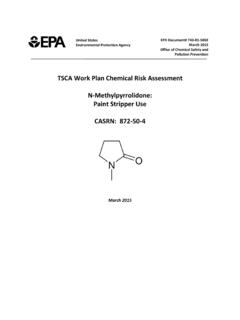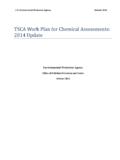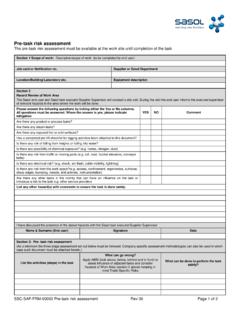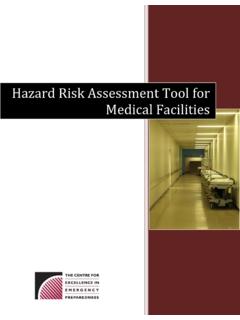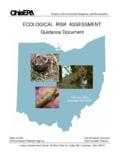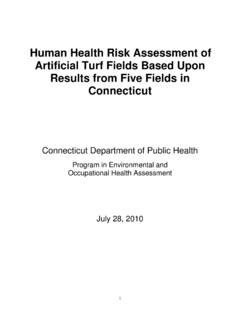Transcription of Example risk assessment: Cleaningcontractor (shopping ...
1 Example risk assessment : Cleaning contractor ( shopping centre concourse)be dangerous and taking HSE guidance into account;talked to safety representatives, and other staff, to learn from their experience, and identify staff needs; andtalked to the shopping centre managers and agreed issues such as: lines and frequency of communication between the cleaning company and the shopping centre management; facilities and equipment available to the cleaners, including storage space and welfare facilities; reporting of near-miss accidents (eg to members of the public) to shopping centre management and risks they discover, such as damaged floor tiles; the security of cleaning equipment and substances, to ensure only trained cleaners can access/use them; and the fire procedures for cleaners. 2 The manager then wrote down who could be harmed by the hazards and For each hazard, the manager wrote down what controls, if any, were in place to manage these hazards.
2 They then compared these controls to the good practice guidance on the HSE website. Where existing controls were not considered good enough, the manager wrote down what else needed to be done to control or eliminate the risk. 4 The manager discussed the findings of the risk assessment with staff, making sure they understood the risks of the job and how these risks would be controlled and monitored. He put a copy of the risk assessment up in the staff kitchen for all staff to see, and made it part of the induction process for new staff, including agency workers. Putting the risk assessment into practice, the manager decided to tackle the most important things first. This included identifying when actions would be done and who would do them. As each action was completed, it was ticked off the plan. 5 The manager decided to review and update the risk assessment every year, or straightaway if major changes in the workplace happened including changes in the use of equipment or chemicals.
3 Setting the sceneThis company provides commercial cleaning services to businesses, employing 60 full- and part-time cleaners. They have won a contract to clean all concourse areas, including outer entrance areas, of a shopping centre. The shopping centre is open from am to pm, every day, and has 24-hour security. General cleaning, by four cleaners, is done from am to pm, and more detailed cleaning, by six cleaners, from pm to pm. An agency worker covers sick and holiday leave. A supervisor is in charge of each shift. Rest facilities for cleaners, including toilets and a small kitchen, are provided at the shopping centre management offices. Cleaning machines, materials and other equipment are securely stored there. How was the risk assessment done?The contracts manager followed the guidance in Five steps to risk assessment ( ). 1 To identify the hazards, the contracts manager:looked at HSE s website for advice on controlling risks in the cleaning industry ( ) and at Business Link for advice on employing temporary workers ( );walked around the concourse, noting things that might Example risk assessment for a cleaning contractor ( shopping centre concourse)1 of 4 pagesHealth and Safety ExecutiveImportant reminderThis Example risk assessment shows the kind of approach a small business might take.
4 Use it as a guide to think through some of the hazards in your business and the steps you need to take to control the risks . Please note that it is not a generic risk assessment that you can just put your company name on and adopt wholesale without any thought. This would not satisfy the law and would not be effective in protecting business is different you need to think through the hazards and controls required in your business for and Safety ExecutiveWhat are the hazards?Who might be harmed and how?What are you already doing?What further action is necessary?Action by whom?Action by when?DoneSlips, trips and fallsStaff and others, including the public, risk injuries such as fractures and bruising if they trip over objects, or slip on spillages or on wet floors, and right cleaning equipment is used for the right job, and staff follow safe systems of work. Anti-slip matting at entrances.
5 Staff monitor entrances for wet floor surfaces walked in. Warning cones placed around spillages, and removed as soon as spillage clear and floor dried. Staff do not leave cleaning materials/equipment unattended. Cleaning of stairs done outside of trading hours. Most cleaning machines used have no trailing cables; for machines with cables, cleaners use socket nearest to where they are working and put out hazard of escalators and lifts done outside trading hours, and to a safe system of work (closed off and isolated, with lift doors open). All areas well lit. Periodic toolbox talks to raise awareness of slips and trips risks . Shift supervisors at least once every 8 weeks7/8/076/8/07 Remind staff that small spillages should be cleaned dry if appropriate, absorbent paper towels can be used. Shift supervisors 7/8/07 6/8/07 Cleaners reminded to wear sensible shoes, eg flat shoes with a good grip.
6 Shift supervisors 7/8/07 6/8/07 Remind cleaners to report damage to floor surfaces to their supervisors7/8/07 6/8/07 Contact with bleach and other cleaning chemicals Staff risk getting skin problems such as dermatitis, and eye damage, from direct contact with bleach and other cleaning chemicals, eg solvents and detergents. Vapour may cause breathing problems. Long-handled mops/brushes, and appropriate gloves, provided and staff trained in their use. All staff trained in the risks , use and storage of cleaning chemicals and wear personal protective equipment as instructed. Cleaning chemicals marked irritant substituted, where possible, for milder alternatives. Staff reminded to report any health problems they think may come from cleaning, and to check for dry, red or itchy skin on their hands. Supervisors7/8/07 6/8/07 Staff reminded to wash gloves and aprons after 6/8/07 Company name: Smith and Jones Cleaners Date of risk assessment : 1/8/07 2 of 4 pagesExample risk assessment : Cleaning contractor ( shopping centre concourse)3 of 4 pagesExample risk assessment : Cleaning contractor ( shopping centre concourse)Health and Safety ExecutiveWhat are the hazards?
7 Who might be harmed and how?What are you already doing?What further action is necessary?Action by whom?Action by when?DoneMusculoskeletal disorders (MSDs) and injuries Staff risk problems such as back pain if they try to lift objects that are heavy and/or awkward to carry, such as cleaning machines or heavy waste bags, or if they are often required to work in awkward postures. All staff trained in lifting safely, and follow safe systems of work. All staff using cleaning machines trained in their use, according to manufacturers instructions. Trolleys provided for moving bags of waste and staff use them. Staff do not overfill bags and buckets. Rubbish skip emptied daily by subcontractors meaning waste bags are not stacked high. Mopping systems have a long-handled wringer, and a bucket on wheels to reduce lifting and carrying. Long-handled mops, brushes and litter pickers provided to reduce need to stretch and stoop.
8 Cleaning machines stored near point of use. Remind staff to tell supervisor if a trolley has defective wheels so it can be taken out of use. Supervisors7/8/076/8/07 Work at height Eg cleaning of windows and fasciasStaff risk bruising and fracture injuries if they fall from any height. No ladders policy. All high-level cleaning done by trained staff working from floor level, using telescopic poles with cleaning tools attached. No further action needed at this stage. Machine cleaning of concourse, and outer areas of entrancesStaff and others risk injury from improper use of the machine, eg if the machine were to buck and hit feet or ankles, or if careless driving results in a pedestrian being struck. Machines provided are the right ones for the job. Cleaners trained in the safe use of machines. Pre-use checks done for damaged plugs, cables and on/off switches. Machines regularly examined and maintained by competent person.
9 Cleaners reminded that if they have doubts about the safety of a machine they are not to use it and to inform their supervisor immediately. Supervisor7/8/076/8/07 Verbal abuse or assault Staff may suffer verbal abuse, and possibly assault, from members of the public and others, particularly if working in quiet or remote areas. Staff trained in dealing with difficult and/or confrontational situations. Staff issued with means of two-way communication, supervisor checks welfare periodically. Staff trained to make supervisor aware when they are working in a remote location. Staff report all instances of abuse. Supervisors reminded to investigate all instances of verbal abuse and inform contract manager of findings and action taken. Manager7/8/074/8/074 of 4 pagesExample risk assessment : Cleaning contractor ( shopping centre concourse)Health and Safety ExecutiveWhat are the hazards?Who might be harmed and how?
10 What are you already doing?What further action is necessary?Action by whom?Action by when?DoneElectrical Staff risk electric shocks or burns from faulty electrical equipment or installation, or from misuse of electrical appliances. Staff trained to perform pre-use checks on cables, switches and sockets before using electrical appliances. Electrical installation tested and maintained by competent people according to a planned schedule. Staff trained in basic electrical safety. Remind staff to do pre-use checks before using electrical appliances. Supervisors7/8/076/8/07 Extremes of weather Staff working outside may suffer discomfort and possibly ill health from exposure to poor weather. Suitable personal protective equipment provided for staff working outdoors. No further action needed at this stage. Collecting waste Staff emptying waste bins, particularly in toilets, risk potentially serious injury from sharp objects, including needles.










